Halloween In London & Dance of the Dead
West End & Hoxton Square. Saturday 30 Oct 2010
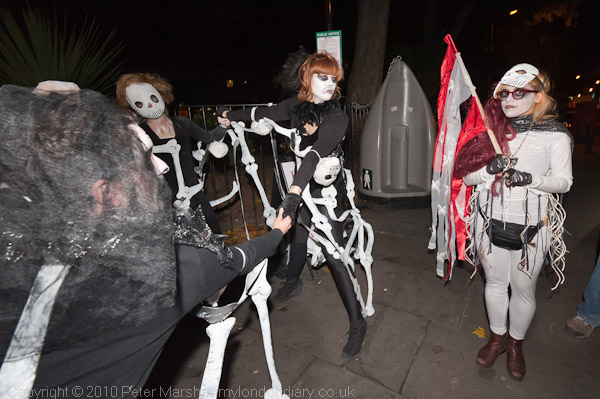
Waiting for the start of the parade of the dead from Hoxton Square
more pictures
Packs of zombies were wandering around London's West End this afternoon,
and later in the day there was a Dance of the Dead Street Parade from Hoxton
Square to Dalston.
I saw several groups of zombies with bloody faces, open wounds and torn clothing
wandering around the streets near Piccadilly Circus during Satruday afternoon.
Some paused briefly to pose with protesters waiting for the 'Life is too short'
demonstration against CCTV and immigration restrictions starting from there.
Later, after it had got dark there was a Halloween Dance of the Dead Street
Parade starting from Hoxton Square, now one of the trendier areas of the city,
making its way up to Dalston where there was to be a Halloween Party. By 7pm,
there were several hundred people ready for the procession to start, including
a group of dancers, the 'Corpse de Ballet' and a group from Strangeworks with
some very well designed costumes, along with many others dressed up for the
occasion.
A samba band, led by a giant skeleton came along from Coronet Street and
led the large group of revellers, many carrying bottles, around Hoxton Square
and then on to Old Street. By this time I'd been out taking pictures for around
8 hours and was feeling tired and hungry, so I jumped on a bus to begin my
journey home, leaving the procession, organised by StrangeWorks Theatre collective
and now in its fifth year, to head on its way to a dance in Gillett Square.
more pictures
Stop Torture in Malaysia
Belgrave Square, London. Saturday 30 Oct 2010
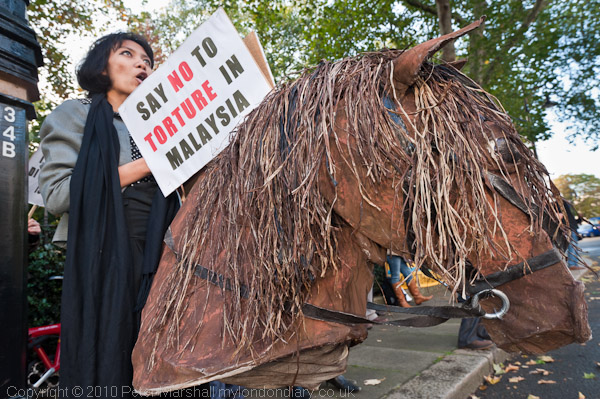
Protest opposite the Malaysian High Commission in Belgrave Square
more pictures
The UK chapter of the Malaysian Abolish ISA Movement (AIM) held
a demonstration at the Malaysian High Commission calling for an end to torture
and other human rights abuses in Malaysia. London, UK. 30/10/2010
This year is the 50th anniversary of the Malaysian Internal Security
Act, under which more than 10,000 people have been detained without trial.
It allows arbitrary detention for up to 2 years without charge, after which
time it can be renewed effectively indefinitely.
It also allows for detainees to be held in incommunicado detention for up
to 60 days. During this time they are often tortured, mistreated and placed
under severe psychological stress while being denied access to legal process.
In June 2010 the UN Working Group on Arbitrary Detention visited Malaysia,
finding that those held in incommunicado detention were often subject to inhumane
treatment. They concluded that the ISA should be repealed and torture in detention
ended immediately.
The London protest was held in October to mark 23 years since 'Operation
Weed Out' (Operasi Lalang) when the ISA was used to arrest over 100 Chinese
educationalists, civil rights lawyers, opposition politicians and others.
It was organised by the AIM, set up in 2001 as an umbrella organisation of
83 bodies, including human rights, pro-democracy, women's rights, student
groups and political activists. The protest called on the Malaysian government
to repeal the ISA, sign the UN convention against torture and to respect the
dignity and human rights of its citizens.
Earlier in the year the AIM had held a demonstration outside the Malaysian
Tourism office in Trafalgar Square on 26 June, the United Nations Day for
Victims of Torture, and they were planning to continue today's action with
a further demonstration there.
more pictures
Life Is Too Short To Be Controlled (Part 2)
Piccadilly Circus, London. Saturday 30 Oct 2010
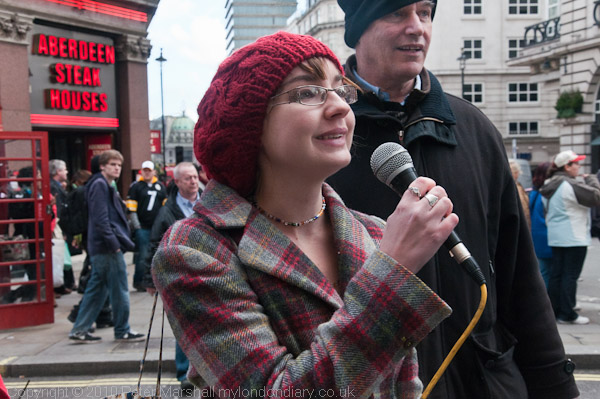
Juliet speaks at Piccadilly Circus
more pictures
Life is Too Short to be Controlled was the second part of an event organised
by London No Borders who marched from the pavement above the London main CCTV
control room at Piccadilly Circus to the UK border at St Pancras International,
protesting about the obsession with surveillance and border control.
Under the pavement at Piccdilly Circus is the Westminster Council CCTV HQ,
which controls many of London's 10,000 CCTV cameras, able to follow our movement
on almost every street in the capital. So it was an obvious starting point
for the second 'Life is Too Short to Be Controlled' protest organised by London
NoBorders.
NoBorders ask why our governments have such an obsession with being able
to spy on our every movement, and link it with a desire to keep tracks on
terrorist suspects and on those with a particular demographic, and with the
potential to control dissent. They point out that despite the widespread use
of CCTV, it has has not been possible to show a link between crimes being
solved and the use of CCTV.
The destination of the march was the St Pancras International Eurostar Terminal,
which is a real border into the UK, including detention facilities run by
the UK Border Agency. As was pointed out in the speeches before the march
set off, until relatively recently the free movement of people was seen as
normal and beneficial - in the same way as we now see the free movement of
goods around the world. Now border controls result in injustice for asylum
seekers and other migrants who want to come here and work and contribute to
our society.
NoBorders believes that no one is illegal, even if they do not have the particular
documents that give them the right to live here. They believe our immigration
rules are explicitly racist and that anyone should be able to move amd live
where they want.
The start of the march was delayed for some time waiting for the bicycle-powered
sound system to arrive for a couple of short speeches before leaving. This
meant I was unable to follow the march all the way to St Pancras. By the time
I returned there after photographing briefly elsewhere, the protest was over,
the group having walked around the station before entering and briefly occupying
the 'border' area there before being escorted out by police.
As they left, one member of the group was detained by police, and I watched
him being led out and put in the back of a police van. He had been arrested
and charged with aggravated trespass, but was expected to be released by the
Transport Police very shortly. It was not clear why he and none of the others
had been arrested.
more pictures
United Friends & Families March
Trafalgar Square to Downing St, London. Saturday 30 Oct 2010
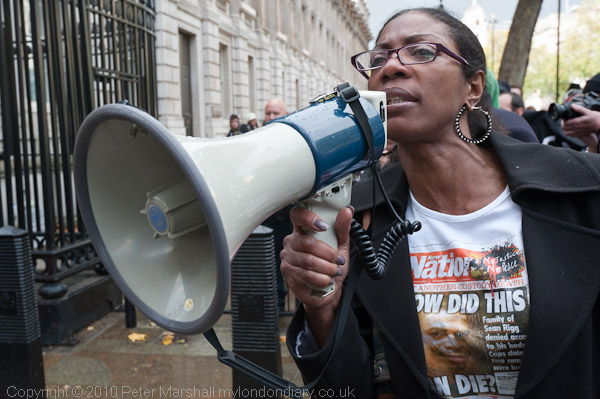
Marcia Rigg-Samuel, sister of Sean Rigg, killed by police in Brixton, tries
to deliver a letter at Downing St
more pictures
The United Friends and Families of those who have died in suspicious
circumstances in police custody, prisons and secure mental institutions marched
slowly in silence down Whitehall to Downing St, where police refused to allow
them to deliver a letter to the Prime Minister, David Cameron.
It's impossible to be sure how many of the suspicious deaths in police custody,
prisons and secure mental institutions (and there are around 200 a year) have
been as a result of lack of care, the use of excessive force and brutality,
but certainly the answer is far too many.
Since 1999, the 'United Friends and Families' of some of those who have died
have held an annual slow silent funeral march from Trafalgar Square down Whitehall
to Downing St. It attracted particular attention in 2008 when the mother and
other family members of Jean Charles de Menezes were among those taking part.
This year's event was rather smaller, and received little attention from the
mainstream media.
A number of family members spoke with great feeling opposite Downing St,
and then the group, by now around a hundred strong, moved across the road
to fix flowers to the gates and attempt to deliver a letter to Prime Minister
David Cameron. It seemed an unnecessary and pointless snub that the police
refused to take the letter and that nobody from No 10 was apparently prepared
to come and receive it.
Earlier there had been an argument with the police who had objected to the
rally occupying one of the two southbound lanes of Whitehall, but was allowed
to go ahead officer in charge after those present had refused to move. In
previous years the police have usually seemed anxious to avoid confrontation,
although in 2008 they insisted on searching all the bouquets before allowing
them to be laid on the gates of Downing St.
Speakers at the rally opposite Downing St included Stephanie, the twin sister
of Leon Patterson, Rupert Sylvester, the father of Roger Sylvester, Ricky
Bishop's sister Rhonda and mother Doreen, Samantha, sister of Jason McPherson
and his grandmother, Susan Alexander, the mother of Azelle Rodney, and finally
the two sisters of Sean Rigg.
What the families want is simple. Justice. And to know the truth about what
happened. What emerged again and again was a shameful history of delay, evasion
and covering up by the police, with the collusion of the IPCC, the Crown Prosecution
Service and even at times judges, working together to ensure that justice
fails to be done. The press have been fed lies - as in the de Menezes case,
security cameras have suddenly been found not to have been working, CCTV tapes
have been lost or doctored, officers involved have not been questioned until
many months after the events, witness statements have been dismissed as 'unreliable'.
Deliberate delays are used as a tactic to prevent the truth coming out, and
these also have allowed officers involved to collude in their cover-ups.
Overwhelmingly the victims in these cases are black, but one of the banners
on the march reminded us that it affects the whole of our community, with
a banner asking why 18 year old Sarah Campbell died in Styal Prison in 2003.
Many of us present remembered and sadly miss her mother, Pauline Campbell;
after her daughter's tragic death she devoted herself single-mindedly to campaigning
for justice, not just for Sarah but for other victims and to improve the system.
Eventually she forced an admission from the authorities that their lack of
care had caused Sarah's death, but she became another victim of injustice
when she committed suicide on her daughters grave.
Leon Patterson was arrested in Stockport in 1992 and kept in a police cell
for some days despite being in need of hospital treatment. He was found dead
in his cell with a fractured skull and severe injuries, his blood covering
the walls of the cell and his genitals mutilated, and in such a bad state
that she failed to recognise him. The family challenged the initial inquest
verdict which found his injuries to be self-inflicted, but there was no legal
aid available for them. Fortunately the charity INQUEST supported them and
a second inquest in April 1993 returned a verdict of unlawful killing, although
this was quashed on appeal by the police on the grounds that the coroner had
misdirected the jury on the law.
Roger Sylvester died in 1999 after being arrested by the Met. An inquest
jury in October 2003 returned a verdict of unlawful killing, but the verdict
was later quashed in the High Court, because the judge claimed the coroner's
summing up had confused the jury. The judge refused to order another inquest
and said that no jury in a criminal case would be likely to convict any of
the officers concerned of manslaughter.
Ricky Bishop was stopped, arrested and taken to Brixton police station on
22 Nov 2001, where he was assaulted and brutalised by police officers, leading
to a heart attack. After that the police called a paramedic and he was taken
to hospital and died. The family say that the police withheld vital evidence
from the inquest and that the jury were not given a proper choice of verdicts
at the inquest.
Jason McPherson died in hospital after being taken there from Notting Hill
Police station after having been arrested on suspicion of drug offences on
18 Jan 2007. Police beleived he had a wrap of cocaine in his mouth and had
used considerable and arguably excessive force on his head and chest to try
to get him to open his mouth. A jury at the inquest in January 2010 came to
a unanimous 'narrative verdict', saying that the procedures were not properly
implemented and that "it did not appear Jason was given the opportunity
to remove the drugs voluntarily through talking down (tactical communication)."
Azelle Rodney was killed by police in April 2005 after a car in which he
was travelling was rammed and stopped by the Met in Barnet. Rodney was not
armed, although the officer who fired the shots at close range was sure he
was. Various misleading statements from police sources were widely published
by the press. An inquiry into the case opened formally earlier this month
and there is to be a hearing in the Royal Courts of Justice starting next
week.
Marcia Rigg-Samuel, sister of Sean Rigg, who went into Brixton Police station
in August 2008 a physically healthy man but was dead a short time later, killed
by the actions of a small group of officers, led the procession down Whitehall
from Trafalgar Square. She stood beside her sister, Samantha Rigg-David, the
last of the families to speak, and then read the letter from the families
to Prime Minister David Cameron. The inquest on Sean Rigg, adjourned in 2008,
is not now expected until 2012.
The families then moved across the road to the gates to Downing Street, demanding
that police open them so they could deliver their letter. Police refused,
and a small group of armed police joined the armed officers already present.
After considerable amount of angry shouting as the police continued to refuse
to allow access or even to take in the letter - a few of the group were allowed
to sellotape the flowers, a photo of Sean Rigg and the letter to the gates.
The noisy demonstration at the gates was still continuing when I left.
more pictures
Around London
London. Monday & Tuesday 25-26 October
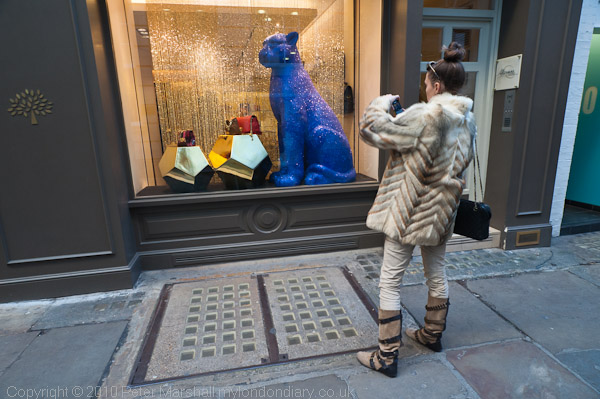
We tried a little street photography, but I had the wrong camera and the wrong
lens
I spent Monday and Tuesday travelling around London to go to various things
- lunch with friends, photography and art shows, a union meeting and a photographers
social evening - and at and on the way to some of them I took a few pictures.
Some of which I think are interesting enough to put in this diary.
more pictures
EDL Rally to Support Israel
Gloucester Road to Israeli Embassy, London. 24 Oct 2010
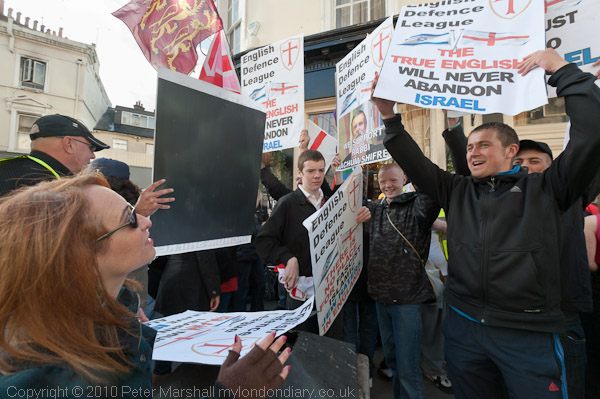 Posters
are handed out to EDL protesters outside the Gloucester Arms pub
Posters
are handed out to EDL protesters outside the Gloucester Arms pub
more pictures
Several hundred EDL members marched to the the Israeli Embassy in London
and held a peaceful rally in support of Israel with Rabbi Nachum Shifren,
a 'tea party' California State Senate candidate as guest speaker.
The marchers gathered at a pub around half a mile from the embassy filling
the pavement outside. I talked briefly with Rabbi Shifren and photographed
him and many of the EDL members present before the march. As on previous occasions,
many of them complained to me that the press wasn't fair to them and presented
a very negative image of the EDL. As usual I told them that I was only responsible
for my own work, in which I've always tried to report in an objective way
on what I saw, both using my camera and in what I wrote, as well as also making
my own difference of opinion clear. If my work ever presented a negative image
it was the result of their actions and not because of me. Although I did get
a little aggression from one or two people, most of those I talked to were
happy to be photographed and several mentioned having seen their pictures
from previous events on my web site, and some thanked me for the reports.
Many complained that they were always labelled as racist. One man from Luton
- where the EDL had its birth - told me that he grew up Muslims, going to
school with them and still knew many of them and that they were at least as
concerned as he was about the rise of Muslim extremism and the actions of
groups such as the Muslims Against the Crusades.
When I suggested that some of the chants heard at EDL events - particularly
those about Allah - were offensive, they agreed with me, but said that it
was impossible to control the actions of all of those attending these events,
although they would like to. It was noticeable today that there were considerably
fewer chants of this nature and they seemed not to be taken up by many of
those present, soon dying away. But if the EDL wants to end the accusations,
they have to take much more positive action to end the kind of behaviour that
makes them possible.
Few of us would want to apologise for the extremes of a small minority of
Muslims, or to live under Sharia law. One of the speakers at the rally suggested
that there were already a number of Sharia courts operating already in the
UK, arbitrating on cases. If so, it follows the practice already in place
for Jewish law, which was not mentioned. The EDL has on previous occasions
given its support to the 'One Law for All' campaign which calls for an entirely
secular system.
As was forcefully stated at the rally, Sharia Law treats women as second-class
citizens, causing great social problems over divorce as well as imposing the
death penalty by barbarous methods such as stoning for adultury or homosexuality.
I was told the EDL has a fairly large gay membership, including quite a few
of those on the march.
The EDL supports Israel because it sees itas a bulwark against extremist
Islamic groups such as Hamas. They say Israel has a right to exist and to
defend itself, but go further in claiming that Palestine has never existed
and they seem to completely ignore any right of the Palestinians to exist,
just because a few of them are radical Muslims and terrorists.
But as I remember from the news reports while I was a child, Israel is a
Jewish state which was set up through terrorism. And it still has a secret
service who continue to carry out terrorist acts, carrying out kidnappings,
assassinations and other attacks in various countries around the world - and
quite recently abusing British passports to do so.
Of course there are Muslim extremists who deny the right of Israel to exist,
just as there are Israeli extremists who would like to exterminate the Palestinians,
but it makes little sense to support either position. Peace in the area -
just as in South Africa or Northern Ireland - will involve some element of
reconciliation, both sides learning to live together, and forgetting the old
rhetoric, and forging some kind of just settlement. It's hard to take the
EDL claim to represent the English people reacting against Muslim extremists
seriously when they themselves would seem to have been hi-jacked by Jewish
extremists - including Rabbi Shifren, who as well as living in California
has a house in one of the more militant Jewish settlements in occupied Palestine.
After the march through the back streets to a pen on Kensington High St opposite
the Israeli embassy, the rally started with a minute of silence for Andy Smelt
from the EDL Halifax Division who died on October 14, and for all the troops
who have given their lives for our country.
While one of the women members of the EDL was speaking, a young man wearing
a black jacket and gloves came up and stood behind her on the outside of the
pen and stopped to listen. He took out a bottle of water and had a drink,
then reached over and poured the rest of it over the amplifier before turning
and running down the street.
The sound immediately cut out and those at the front of the crowd listening
pushed through the barriers and tried to chase him, followed by a small crowd
but were held back by stewards and police. I managed to slip out through the
police line, but by this time he had disappeared. The police seemed rather
slow to realise what had happened and apparently failed to catch him. Later
I heard they thought he had hidden inside the underground station, but I suspect
he really caught a train there.
I'm unhappy with the idea of suppressing free speech - so long as it stays
within the law - that his action represented, though the damage to property
(assuming there is some long-term damage) might well not be a case for the
police as a civil offence.
After a few minutes the organisers managed to calm the crowd down, and, after
the water had been shaken out, the electronic equipment came back to life,
although with a great deal of crackling for the rest of the rally.
Rabbi Nachum Shifren received a very enthusiastic welcome from the crowd.
He is a part of the 'Tea Party' movement in the USA and a candidate for the
state senate in Sacramento. His policy leaflet suggests improving education
by making students and parents accountable for academic performance and opposing
the teaching unions and tackling crime by shutting down the prisons and housing
prisoners in tent cities, as well as putting a complete stop to illegal immigration.
As well as this he would work to "create a fertile business climate"
and introduce new technology to modernise state business. He also believes
that if California was taken out of the hands of the "radical environmental
political machine" there would be no energy problem there. His leaflet
doesn't otherwise mention environmental issues.
Unfortunately it was difficult for me to hear all of Rabbi Shifren's speech,
partly because of the damaged amplification, but also because I was moved
away by the police who were restricting access to the area in front of the
protest, and I went to photograph the small group of perhaps 40 counter-protesters
from the UAF and other groups (there were also a few more outside the pen
on the opposite side of the road.) Shifren made clear his opposition to Sharia
Law and Muslim extremists and I think to any aspect of multiculturalism, and
he also spoke for some minutes in Hebrew, expressing his support for Israel.
The leaflet for the London Division of the EDL says that they "are
the knights of old, defending our great nation for the threat of Militant
Islam" and "All welcome no matter of colour, religion or
sex." It also states "We do not support racism or intolerance
of any kind".
Intolerance isn't necessarily bad - there are things that I think we should
be intolerant about, and for me these include both a fundamentalist implementation
of Sharia Law and racism. Although I think that the EDL, in London at least,
has made some effort to police the racists in their ranks, there was an atmosphere
of hate that I found depressing in some of the actions, chants and the speeches.
Having met and talked with some leading members of groups such as March For
England and of the EDL, I have some respect for their good intentions against
racism, but on the ground their movement has been deeply infiltrated by racists
and bigots, and they have yet to develop any truly effective method to combat
this. Although the EDL claim to be opposing the rise of fascism in their opposition
to Muslim extremists, they have come to a very biased view over Israel and
Palestine, and have been very effectively infiltrated by bigoted Zionists.
Perhaps over time this is something that may also change, as it seems to be
in conflict with their stated position on racism and intolerance.
Unite Against Fascism failed to mobilise any effective opposition to this
demonstration - and did not appear to have tried very hard to do so. After
the event I went to their web site where I found this statement: "UAF
does not have a position on the question of Israel and Palestine – our
members have many different views on this question. Instead, we unite around
our common aim of opposing the rise of fascism." Perhaps on this
occasion they felt that taking action might offend some of their Jewish supporters.
At the end of the rally a few of the EDL went to the end of the pen closest
to the counter-protest for a few minutes of shouting back at them, with both
groups exchanging insults. As they seemed to be beginning to leave with the
rest of the group to march back to their dispersal point I left to catch the
tube and go home.
Although the protest to that point by the EDL had been peaceful and well-ordered,
many of the EDL, along with Rabbi Shifren, went on to Speakers Corner, where
they apparently met with considerable heckling. The following day I met a
photographer who was there and he told me that a small group of EDL supporters
had attacked a Muslim bookstall and the 11-year-old boy who was running it,
and then turned on photographers for taking pictures of their actions. His
camera was smashed into his face by an EDL supporter. Looking at photographs
on the web confirmed his story.
more pictures
Bloomsbury Festival
Bloomsbury, London. Sat 23 October 2010
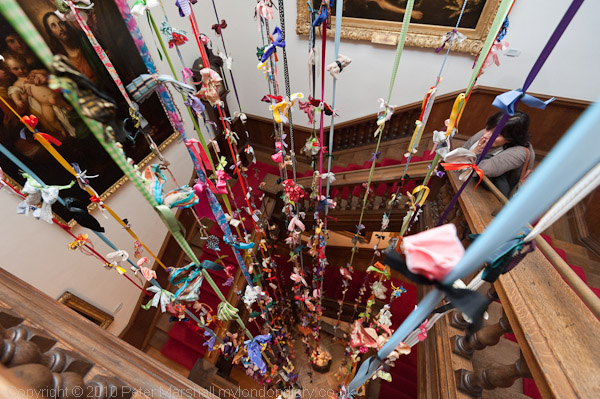
Modern cloth strips at the Foundling Museum, where 'Threads
of Feeling' is showing.
more pictures
I've not noticed previous Bloomsbury Festivals in 2006 & 2007, and unfortunately
because of other committments I missed most of the more interesting sounding
events this year, but I did manage to take a tour of the area on the Saturday
afternoon and found a number of things of interest .
There were free events taking place across the area, in museums and galleries,
parks and gardens, as well as various dance and film performances, exhibitions,
walks and tours and workshops. I did my own walk through the area, taking
in most of the squares and parks in which there were varous artworks and visiting
a few of the museums and exhibitions.
If I'd had more time, there was a lot more I'd have liked to do. But much
of the interest I found in the afternoon was in the area itself - with some
'found art' perhaps more interesting than some of the festival pieces. But
it did let me in to a charming private garden in Malet St (where the trees,
leaves and the grass roller excited me considerably more than the work of
photographic art strapped to a cople of trees) and to the Foundling Museum,
which has an incredibly moving show of the pieces of 18th century cloth, textile
tokens left by mothers with the babies taken to the Foundling hospital in
the hope they could later be identified.
more pictures
Trade Union March Against Cuts
Euston Rd to Bedford Square, London. Sat 23 Oct 2010
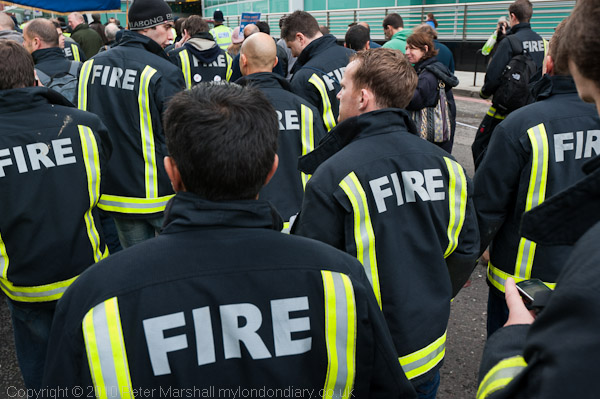
London Firefighters on 8 hour strike led the march
more pictures
Striking London firefighters led a march of several thousand trade unionists
and activists through London to a rally in Bedford Square against the Government's
plans to cut front line services. London's firemen were picketing outside
fire stations and taking part in the march against the cuts announced by Chancellor
George Osborne in Wednesday's Comprehensive Spending Review.
The firefighter's 8-hour strike started at 10am today and is in response
to an ultimatum by the employers who on August 11 began the legal process
of firing 5,600 London firemen in a move designed to bully them to agree to
a new contract. In an unusually high ballot turnout - 79% - the workers voted
by the same majority to take strike action.
Their employers, the London Fire Brigade (LFB) had previously been negotiating
with the Fire Brigades Union, and the union blames the new aggressive conduct
of the LFB on the Conservative chair of the London Fire and Emergency Planning
Authority.
Similar aggressive tactics - firing workers and then offering re-employment
on a less favourable contract imposed without negotiation by the employer
is also being attempted by Birmingham City Council for their 26,000 workers
and by Sheffield who have sent similar letters to their 8,500 employees.
With the spending cuts it seems inevitable that other local authorities and
public sector employers are likely to try and force similar 'agreements' on
to their workers, and we are likely to be in for considerable industrial strife
over the coming years as the cuts bite.
It was a long procession with many trade union and other banners that made
its way to the rally in a corner of Bedford Square, which was addressed by
several leading trade unionists including RMT General Secretary Bob Crow.
After the rally some of those taking part went on to attend a rally against
the cuts in the nearby TUC HQ Congress House, organised by the South-East
Region TUC.
Similar events were organised in other cities including Cardiff, Manchester,
Bristol, Lincoln and Wigan, but one of the calls at the rally was for a much
greater response by the TUC, and the bringing forward of the national demonstration
planned for next Spring. The London march and rally was called by the RMT,
FBU, NUT, PCS and the National Shop Stewards Network.
more pictures
Windsor Waste
Windsor, Berks. Fri 22 Oct 2010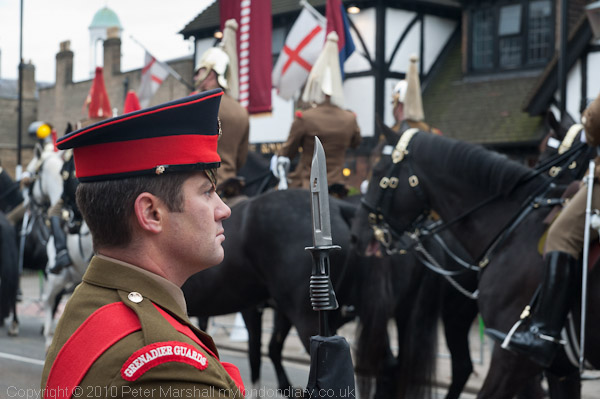
Grenadier Guard with bayonet and military band
more pictures
I went to Windsor for a walk with my wife and my son's wife and her daughter
and spent some time pushing a pushchair before we had a rather nice pub lunch.
But when we arrived the streets were full of soldiers on horses, rehearsing
for the state visit of the Emir of Qatar a few days later.
This is a whole layer of our military that could well be cut we thought,
as we saw some thousands of pounds of our taxes being wasted. I don't know
how much is spent on keeping all the horses we saw, but I don't think the
cavalry are a great deal of use in fighting our wars. Of course we could really
do without all of our armed forces, which would stop us getting into hopeless
wars as a poodle of the USA, who seem to have learnt nothing from Vietnam.
more pictures
TINAG & London at Night
Hanbury Hall, Spitalfields etc. Thur 21 Oct 2010
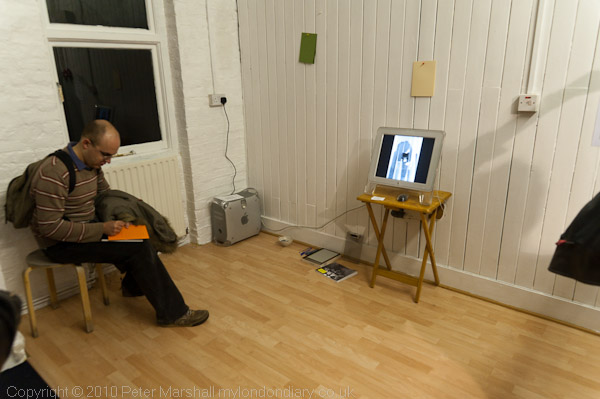 Someone
makes a confession for David Boulogne's wall at TINAG
Someone
makes a confession for David Boulogne's wall at TINAG
more pictures
I went to the opening of the TINAG festival (it stands for 'This Is Not
A Gateway') in the Hanbury Hall, stopping on the way there to not
photograph Amy Winehouse, and on the way back walking to the bus stop
and from the bus I also took some more pictures.
Last year Paul Baldesare and I both did a short presentation on our work
in the show 'Taken in London' for
TINAG, but this year I hadn't got
round to taking part.
more pictures
Paris • New York • London Opening
Shoreditch Gallery, Hoxton Market, London. Wed 20 Oct 2010
.JPG)
Me (with the hand) and others at the opening - all pictures
in this section © Paul Baldesare, 2010
more pictures
We had a nice evening at the Shoreditch Gallery and a decent attendance despite
the other events that were on. It was good to see old friends again and to
meet a few new ones.
The gallery owner reports a more than usual number of people coming to view
the show over the three weeks it has been on so far, and I've had rather more
positive feedback than in previous years. I've also now sold most of the copies
of my book, Photo Paris, that I ordered for the occasion, which although I
sell it with only a very small mark-up (and because I bought a number of copies
before the recent Blurb price rise rather cheaper than on-line), is encouraging.
Thanks to Paul Baldesare, another of the three photographers in
the show, for sending me some pictures. I also saw John Benton-Harris
taking some, but I haven't seen them yet. As you can see I was too busy talking
to use a camera.
more pictures
March Against Spending Cuts
Malet St & Lincolns Inn Fields, London. Wed 20 Oct 2010
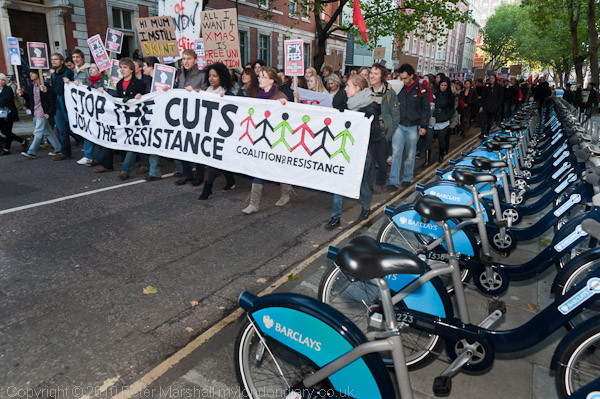
Students set off on the march to Lincolns Inn Fields
and then on to Downing St
more pictures
Today the government announced the results of their comprenhensive spending
review (CSR) which will involve considerable cuts in welfare benefits and
the loss of many public sector jobs as services are cut.
I saw George Osborne being driven ot of Parliament (though didn't bother
to try and photograph him when the guys I'd been talking to as I walked past
sprung into action), looking pleased with himself. The defecit left by the
outgoing New Labour government has given the Tories in the Con-Dem coalition
a perfect excuse to slash the public sector and privatise services in a way
they would never have dared before. Big business must be rubbing its hands
with glee at the thought of the profits it will be able to make in the health
service, from so-called 'free schools' and elsewhere.
For the ordinary working people and the unions that represent some of them
the prospect is truly bleak. More than a million jobs to be lost (some replaced
in the private sector on lower wages, fewer benefits, lower standards of delivery
and safety and higher workloads.) A typical story hit the papers this week,
of a man reduced to a near-vegetable state when an agency supplied a nurse
without proper training to look after him; its the kind of thing we can expect
to see multiplying across every sector as private companies come in and profit
comes before anything else - though they call it 'efficiency.'
I couldn't stay for the rally at Downing St, as my show 'Paris - New York
- London' was opening at the Shoreditch Gallery and I had to be there to make
a speech and meet people, but I did cover the feeder marches, starting with
the students in Malet St and then the trade unionists who gatherd in Lincolns
Inns Fields and were joined by the students.
The Coalition of Resistance who called the protest against the £83
billion to be cut from public services say that this will plunge the economy
into a slump.
Rather than cutting jobs, pay, pensions, benefits, and public services that
will hit the poor ten times harder than the rich, they urge the governemnt
to cut bank profits and bonuses, tax the rich and big business. Rather than
contract out the NHS, they should axe Trident and withdraw from Afghanistan.
They state: "Cuts on the scale of the 1930s will produce unemployment
on the scale of the 1930s. What we need is massive investment to create jobs,
regenerate the economy, and provide the goods and services people need. In
particular, we need massive investment in renewable energy and public transport
to begin the transition to a green economy."
more pictures
Jesse Jackson & Christian Aid Lobby
Westminster, London. Wednesday 20 October 2010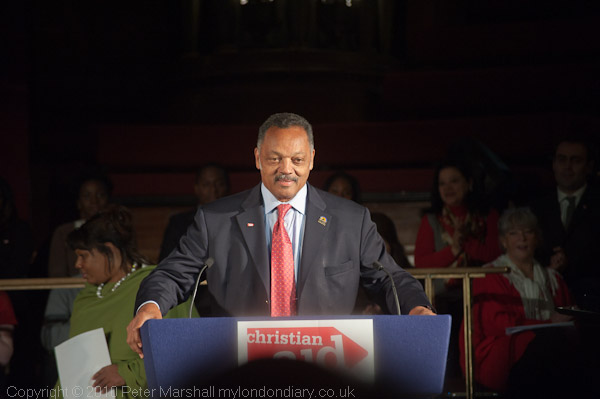
Jesse Jackson stands wiating for the applause to die
down so he can give his address
more pictures
I was among the 2,500 Christian Aid supporters who came to Wesminster to
lobby their MPs on 20.10.2010, asking them to press for transparency and fairness
in the global tax system and for action on climate change.
Their campaign for tax justice estimates that various forms of tax dodging
by major companes robs poor countries of more than $160bn a year, while climate
change and the natural disasters it is bringing have a vastly greater impact
on the poorer countries who are most vulnerable, despite their much lower
per capita carbon footprints. They suffer from the results of our high dependence
on fossil fuels.
The day started with an event in Westminster Central Hall, a vast place opposite
Westminster Abbey, and, as we were reminded is where the United Nations started.
Speakers included the new director of Christian Aid, Loretta Minghella, Suzanne
Matale from Zambia, secretary of state for international development and MP
for Sutton Coldfield, Rt. Hon Andrew Mitchell MP, and the Rev Jesse Jackson
president and founder of the Rainbow PUSH Coalition.
After the speeches and a rushed lunch we hurried to meet Spelthorne MP Kwasi
Kwarteng, who spent some time with us discussing the issues, particularly
over hedge funds and tax havens. He had agreed to meet a small group of us
from the constituency outside the parliamentary offices, which saved us all
the hassle of queing and going through security. Others from the lobby were
still waiting in long queues outside Parliament when I left to make my way
to another event.
more pictures
Roundheads Remember the Dead
The Mall & Horseguards Parade, London. Sunday 17 Oct 2010
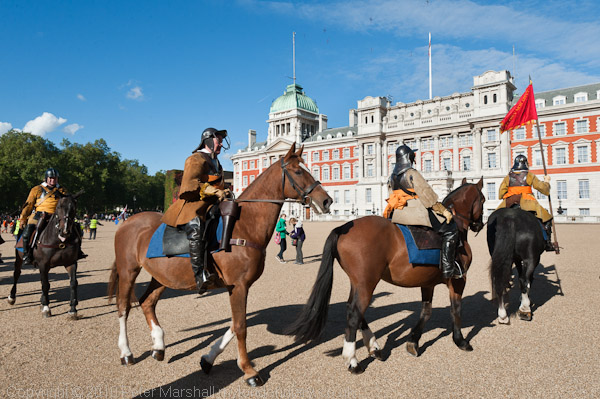
Roundhead cavalry leads the Roundhead New Model Army onto the parade ground.
more pictures
The Roundhead Association of the English Civil War Society
marched along the Mall for a parade at Horeseguards marking the anniversary
of the hanging, drawing and quartering on 16 Oct 1660 of some of those responsible
for the execution of Charles I.
For some years the 'Kings Army' have held a ceremonial parade through London
on the last Sunday in January to mark the anniversary of the execution of
King Charles I on 30 January 1649. This year was the first occasion that the
'Roundhead Assocation', the other side of the English Civil War Society, had
held a similar event in the centre of London. Rather than march into Whitehall,
the event took place on the Mall and Horseguards as the Metropolitan Police
had demanded a fee of more than ten thousand pounds to stop traffic in Whitehall.
After the restoration of the monarchy in 1660, a general pardon - the Act
of Indemnity and Oblivion - was granted to those who had fought for Parliament,
with the exception of those who played a direct part in the trial and execution
of the king. Six of these so-called 'regicides' - John Carew, Gregory
Clement, Thomas Harrison, John Jones, Adrian Scrope and Thomas Scot - were
found guilty and sentenced to be hung, drawn and quartered along with the
captain of the guard at the trial, Daniel Axtell, the leading prosecutor,
John Cook and preacher Hugh Peter. Colonel Francis Hacker, the commander of
the guard at the execution was sentenced to be hung, nineteen others were
imprisoned for life and a few pardoned.
Harrison's sentence was carried out at Charing Cross on 13 Oct, 1660, Samuel
Pepys recording the event in his diary: I went out to Charing Cross, to
see Major- general Harrison hanged, drawn, and quartered; which was done there,
he looking as cheerful as any man could do in that condition. Carew followed
at Charing Cross on 15 Oct, Peter at Charing Cross and Cook at Tyburn on 16
Oct, Clement, Jones, Scot and Scrope at Charing Cross on 17 Oct, and Hacker
and Axtell at Tyburn on 19 Oct. Three of the others who had fled the country
were later arrested and also executed.
Several hundred members of the Roundhead Association in period dress made
this a colourful spectacle as led by a small troop of 11 cavalry with a standard
'Et Dieu Mon Appuy' (And God my Support" they marched up the Mall
towards Horseguards Parade. There they held a lengthy ceremony in which various
officers of the regiments were awarded warrants. The web site lists eleven
regiments of foot (infantry) and two artillery companies in which members
can enlist to take part in events such as this, and there were also a group
of camp followers - women and children - at the rear.
From Horseguards Parade, the Parliamentary New Model Army marched to Admiralty
Arch, close to where the executions at Charing Cross took place. A colour
group of four marched with a wreath to the statue of Charles I in Trafalgar
Square - the message on it read:
"In Commemoration
of all those who fought for The Good Old Cause of Parliament,
especially those vilified as
The Regicides
who carried the vision of a free people in their hearts
and some of whom died horribly in its name.
Also in Remembrance
of all those, of whatever side, who lost their lives,
their relatives and friends, and their livelihoods during
the English Civil Wars 1642-1651.
Lest their sacrifices be forgotten
and there was then a short speech reminding us of the bravery with which
the regicides faced their horrific deaths, before the army marched away back
down the Mall to there dispersal point.
The English Civil War Society aims to stimulate interest in military life
of the seventeenth century and insists that its activities are not in any
way political. But events such as these do remind us of some of the basic
issues of liberty and freedom that are remain important today.
more pictures
Brighton, Biennal and Photo Fringe
Brighton. Tues 12 Oct, 2010
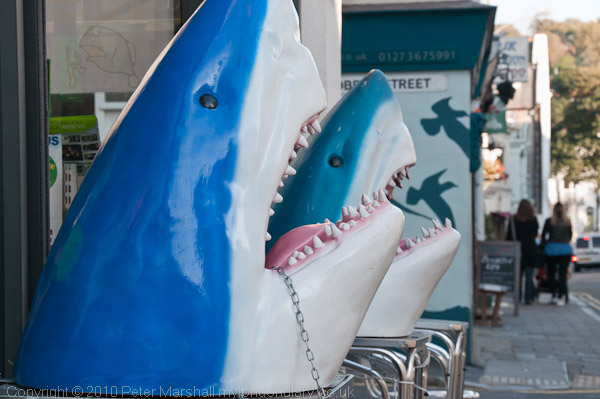
Fish on a Brighton street
more pictures
I hadn't realised that so many shows in the Biennal and Photo Fringe would
be closed on a Tuesday - with the largest site in the whole event, The Old
Co-op Building only open Friday to Sunday. Others are closed on Sundays, so
the festival is only in full swing for two days a week, Friday and Saturday.
But in fact I had little choice of the day I went as it had to fit in with
the activities of our guests, and we all came to Brighton on Tuesday. After
a visit to the museum, where I looked at the Biennal show and they looked
at the other galleries (which did seem considerably more interesting) we went
to have a fish and chip lunch and then split up with me searching for those
galleries that were in business with the help of the Photo Fringe map and
booklet.
It wasn't straightforward, and I gave up with a few that should have been
there of which I could find no sign, and one or two I did find needed only
a very short visit. But there were things worth seeing and I wrote about several
of them on >Re:PHOTO.
As I walked around I did take the occasional picture, including some of several
of the shows I visited.
more pictures
Carter's Steam Fair, Windsor & Eton
Englefield Green, Windsor and Eton. Sunday 10 Oct 2010
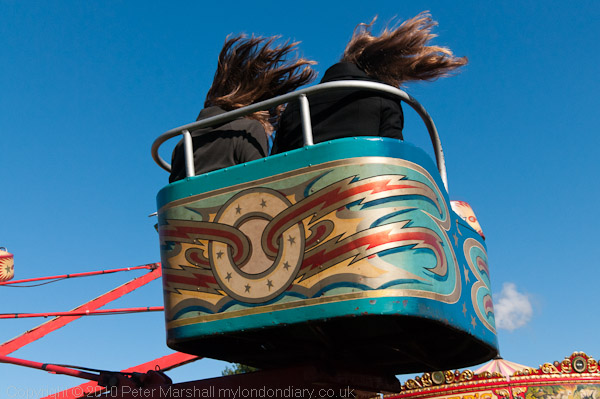
Our two young visitors enjoying the ride - rather them than me
more pictures
Saturday evening Linda was waiting rather anxiously at Heathrow for our visitors
at Heathrow when her phone rang. It was an immigration officer quizzing her
about the two teenage girsl she was meeting but hadn't turned up although
the rest of the passengers from the flight from Hamburg had already come past
her. Eventually she was able to persuade the authorities that we really weren't
bringing them into the country for immoral purposes but that they were staying
with us for a holiday.
One of them was the granddaughter of the German girl Linda had started writing
to fifty years ago. In 1985 I produced an exhibition, 'German Indications'
with images and texts based around our visits to stay with her in Germany,
and 12 years later I put it on the web. It's still there, with some minor
revisions, but still with the bad scans that were as good as anything on the
web at that time (though when I eventually got a colour scanner I did replace
some of those that said 'original in colour' with equally bad colour scans.)
At some point I'll revise it again and bring it out as both a revamped web
site and a print on demand book.
On Sunday we took our guests for a pub lunch (they turned down the English
food on the menu we had taken them for and both had continental dishes) and
then (eventually) caught a bus to Carter's Steam Fair on the green at Englefield
Green. They enjoyed their ride on the Octopus, though I'm rather glad I didn't
try it. It was hard enough trying to keep up with it looking through a camera,
though the Nikon autofocus did a pretty impressive job - I could only have
got the occasional picture sharp with manual focus, while almost every frame
here was sharp.
Another bus (only 15 minutes late - the first had been 35 minutes behind
time) took us on to Windsor, where we arrived just as the castle was closing.
You used to be able to walk around quite a bit inside for free, but now you
are kept out unless you pay, but fortunately none of us was that interested.
It looks better from the outside in any case.
We wandered a little around Windsor, then went and had a look at Eton, were
we went up to the college end of the High St. Our German visitors found the
few boys we saw in uniform pretty hilarious. So do I, but it's rather less
hilarious that it's those guys who will be our government in 25 or so years
time. Eton is probably a very good school, but it is the very pinnacle of
our rotten class-ridden society. Earlier in the day we had been reading how
almost nobody in Germany sends their children to be educated privately. It's
pretty sickening at the moment to hear a largely Eton-educated government
talking about making a fairer society, when the most basic thing needed to
bring that about is an end to the privileged education system for the rich
that underpins unfairness here. I'll start taking them seriously when they
bring out their plans to make private education illegal.
more pictures
Don't Cut Science
The Treasury, Whitehall, London. Saturday 9 Oct 2010
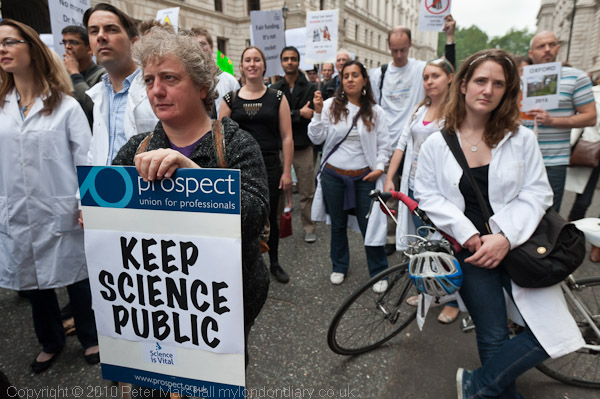
The rally outside the Treasury in King Charles St
more pictures
Around 2000 people, mainly scientists, attended a rally outside the Treasury
in London to give George Osborne the message that continued investment in
science is essential for our future.
The protest, which filled much of King Charles St, off Whitehall was organised
by 'Science is Vital' coalition, an organisation only set up a few
weeks ago by biochemist Dr Jenny Rohn of University College London, who soon
attracted an organising committee including otheSr scientists and a wide range
of science-related organisations.
The speakers were introduced by Dr Evan Harris, a former NHS doctor and Lib
Dem MP from 1997 to 2010 who lost his seat by just 176 votes in the May election.
Harris had been named 'Dr Death' by the Daily Mail who demonised him for views
on abortion, voluntary euthanasia, immigration and gay rights" and whose defeat
was widely seen as a vote against science.
Most eminent among the speakers was Professor Colin Blakemore, former head
of the Medical Research Council, who came out with some strong statistics
in support of British science, which is currently already grossly underfunded
- with the lowest investment among all the OECD countries except Italy, and
one fortieth the investment in science of the USA. Despite this, Britain punches
very much above its weight across the sciences, second only in most areas
to the USA, producing 14% of publications.
As he and other speakers pointed out, despite our small size and low investment,
Britain leads the world in many scientific disciplines and we have 29 of the
world's top 200 universities, including three rated in the top ten. Around
90% of funding from the Higher Education Funding Council for England (HEFCE)
goes to research that is rated as ‘internationally excellent’ or ‘world-leading’.
The protest came at the end of a week in which a British scientist had been
awarded the Nobel Prize for Medicine and two Manchester based scientists the
Nobel Prize for Physics.
Some speakers had more personal stories. Vivenne Hill spoke about caring
for her mother who had suffered from Alzheimers and of the great need for
more research to find treatments in many areas such as this, and cancer survivor
Claire Daniels spoke in some detail about the succesful treatment of her condition
- and that without the great deal of research on which that was based she
would have died.
Despite the seriousness of the campaign it was a protest marked by a great
deal of humour from most of the speakers, as well as the two science comedians
Timandra Harkness and Dean Burnett. There were also plenty of witty placards,
of which my favourite was 'We need a fair share of the ?!'
Some of the others:
Science – It beats living in a cave!
Banking doesn’t cure disease
Up and Atom!
Science: More useful than a duck island.
Science: Because alchemy’s a myth
Fair funding. It’s not rocket science.
No more Dr Nice Guy!
Science saves lives
Do the math. Science = Growth
Do you guys not want jetpacks or something?
My other coat is a lab coat!
Science: I’m Lovin’ It!
Cut the nonsense, not the funding
and there was also a somewhat hilarious quasi-musical performance led by
Evan Harris in which the crowd was urged to join.
Other speakers were materials scientist Mark Miodownik, Simon Denegri of the
Association of Medical Research Charities, Michael Brooks who stood at the
last election as an unsuccesful candidate for The Science Party, the General
Secretary of Prospect, the main trade union doe scientists, Paul Noon, Campaign
for Science and Engineering director Imran Khan, Sex educator and agony aunt
Dr Petra, and science writers Simon Singh and Ben Goldacre.
Already over 24,000 have signed the petition on the campaign web site. Next
Tuesday, 12 October, scientists will be going to labby MPs and hold a meeting
at Parliament. By then the government should have got their message that making
cuts in science funding is economically absurd, with increasing national income
crucially dependent on science-based innovation. Making cuts in science in
the spending review to be announced on October 20th would be shooting the
economy in the foot.
more pictures
Democracy Village People's Assembly
Trafalgar Square & St James's Park, London. Saturday 9 Oct 2010
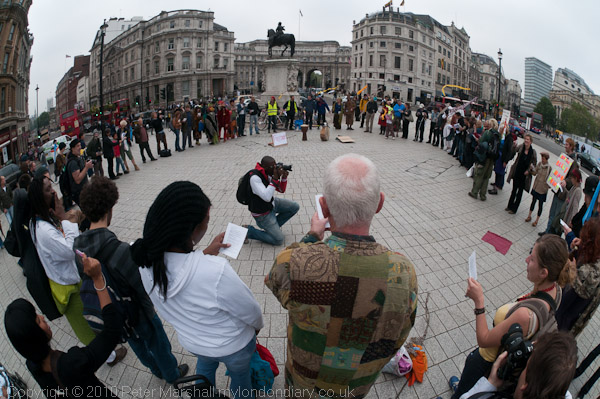
The people's assembly form a circle to sing 'World Turned Upside Down'
more pictures
Around 65 people, most of whom had been at the Parliament Square Peace Camp,
met for a democracy rally at Trafalgar Square, moving to St James's Park for
an afternoon of talks, music, performance and discussion. London, UK. 09/10/2010
Many of those who camped in Parliament Square as the Democracy Village from
May 1 until evicted in July this year continue to meet in central London as
the Democracy Village People's Assembly.
This Saturday they invited friends to participate in a Democracy Rally in
Trafalgar Square, where I talked to them briefly around 12 noon. The main
part of the square was in use for an event celebrating 50 years of independence
for many African countries, and it was busy and filled with joyous but rather
loud music, so the Democracy Villagers decided they to meet up around the
equestrian statue of Charles II at the south end of the square and then march
together around 1pm to a more suitable location for their event.
A little after 1pm, those present formed a circle and held hands to sing
together 'World Turned Upside Down' a Leon Rosselson song popularised by Billy
Bragg about the Diggers who set up camp on St Georges Hill in Weybridge in
1649, which the Democracy Camp use as the start of their meetings.
The Diggers, puritans also known as 'True Levellers' took seriously the New
Testament example of holding everthing in common and in particular saw the
earth as provided by God as 'a common treasury.' They had a strong belief
in the equality of all and defied the laws of property by occupying and cultivating
common and unused wasteland, but were forcibly evicted and dispersed. One
of their leaders, Gerrard Winstanley, himself wrote a song about it - The
Diggers' Song - Rosselson's is not based on this but does make use of some
of his other writings.
After this many of them took part in a group hug, and when someone in the
middle shouted out they were finding it difficult to breathe I queried, "Did
you say breathe or breed?"; then Chris Knight then shouted out "I'm
pregnant!" and the group broke up laughing.
By now they had attracted quite an audience of tourists and a few others.
But the onlookers were left behind as the group made a procession led by Knight
beating a drum and a white rabbit, Flopsy Bunny along with Phoenix with a
peace flag and Simon with a megaphone. Most of those present joined a procession
that went through Admiralty Arch and along the Mall to St James Park.
There the group together came to a decision about where they would stop,
and after a short discussion and a song, split into several smaller groups
for discussions about democracy, the environment and other social issues.
I left them sitting under the trees and went to attend another event.
more pictures
Excalibur Estate
Downham, Catford, London. Thursday 7 Oct 2010
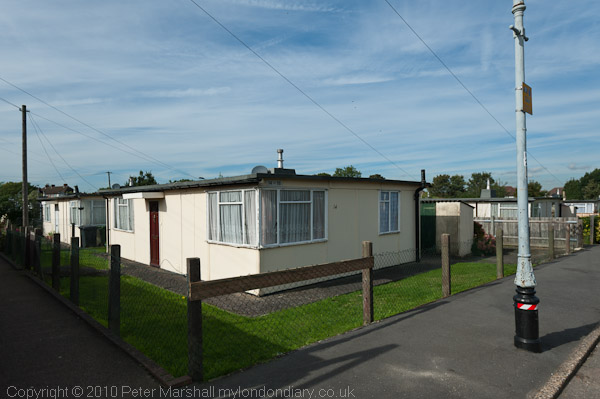 The last remaining 1945 prefab estate looks set for redevelopment
The last remaining 1945 prefab estate looks set for redevelopment
more pictures
The Excalibur estate is the only substantial example remaining of a number
of pre-fab estates constructed as the Second World War ended for returning
soldiers and their family. Although intended as temporary dwellings, they
were basically well-made and equipped with all mod cons including fitted kitchens,
refrigerators, built-in cupboards and heated towel rails. Like most such estates
it was erected by prisoners of war.
Intended only to last for 10 years, many of the prefabs need extensive refurbishment,
particularly as Lewisham council has no kept up with repairs, having decided
years ago it wanted to demolish the whole estate.
Finally it seems that this is likely to happen soon, and the council will
transfer the estate to a housing association for redevelopment shortly, following
a vote by a small majority of residents for the regeneration plan. Some still
intend to keep up the fight which has already led to the Grade II listing
of a small block of six prefabs on the estate. There is a longer article about
the estate on >Re:PHOTO.
more pictures
Human Rights in the Phillipines
Amnesty International, London. Wednesday 6 Oct 2010
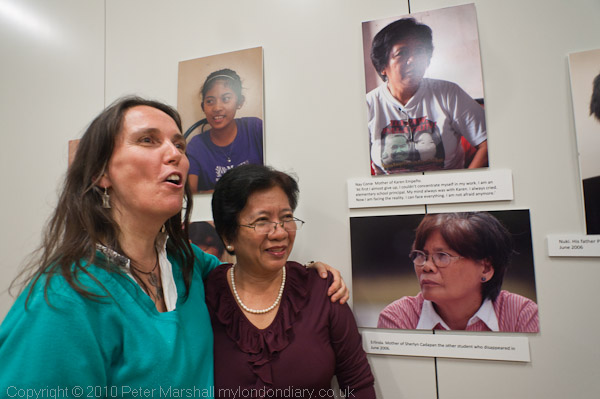
Photographer Isabelle Merminod with Concepcion (Conie)
Empeno, mother of forcibly disapperaed student activist Karen Empeno in front
of Isabelle's pictures of her and other Phillipine human rights activists.
more pictures
It came as a surprise to me to learn that the Phillipines is the second most
dangerous country for journalists - after Iraq, and also the second most dangerous
in which to be a trade unionist - after Colombia.
We don't hear much about human rights abuses there is simply because it isn't
considered news by the media. The major US companies that lead the pack concentrate
on countries where abuses can be blamed on Muslims, communists or some other
capitialist bogy men. The Phillipines is still seen by American very much
as a US project; it was US colony from the Spanish-American War in 1898, until
being given independence in 1946.
The constitution is democratic in name, but entrenches power in the provincial
elites who are able to rig the elections using the traditional guns, goons
and gold. Those who can't be bribed can be persuaded to vote the right way
by thugs with guns.
These thugs with guns - the police, parts at least of the military and vigilante
squads (mainly police and/or military in plain clothes) are also responsible
for the high level of human rights abuses, including enforced disappearances,
torture and extra-judicial killings.
Raymond Manalo, a young farmer, with the aid of an interpreter,
told the story of his abduction by the military in Feb 2006. They forced him
and his brother into a white van outside their home as his parents watched
and drove to a camp where he was tortured regularly for several months before
being put in a detention cell with 17 other abductees. They were fed only
once a week and regularly tortured. He tried to escape, was captured and petrol
was poured over him, but he was saved from death by a phone call from someone
the guards called 'Madam' who said he should not be killed yet. After that
he got medical attention for the injuries from his torture and was moved to
another camp. There he met other people who had been dissapeared, including
students Karen Empeno and Sherlyn Cadapan, who were being
abused and raped by the guards (the interpreter found the fuller details of
their treatment too offensive to translate.) There to he was a witness to
the killing of the farmer who had tried to help Karen and Sherlyn, Manuel
Merino (and after his escape he was able to lead people to the spot where
his body had been burnt, and the remains were identified.)
Raymond and his brother were told they could save their lives by becoming
soldiers and working with the military, and having agreed to do so were moved
to work on a farm owned by one of the Generals - still kept under guard. While
there they took advantage of a festival when all the guards got very drunk
and managed to escape and make their way to Manilla, where they found a human
rights organisation that got a judge to grant him protection and filed a legal
case against his torturers. This was dismissed on technical grounds but is
still being appealed.
One of the other speakers from the Phillipines was Karen Empeno's mother,
a primary school teacher. Karen had volunteered to help a farmer's organisation.
In 2006 she was grabbed by men in military uniform and thrown into a jeep,
along with a farmer, Manuel Merino, who had tried to help her. Two days later
her mother heard about her disappearance; she searched the hospitals, went
to the radio and TV studios for interviews and filed a habeas corpus at the
Supreme Court, but could get no information anywhere about her daughter. Connie
Empeno said "I am not an activist" but she "became
a spokeperson for my missing daughter and other victims of dissaperances...The
only hope I have left is that she is still alive."
Karen and her colleague Sherlyn, seized at the same time are only two of
the 208 documented enforced disappearances during the presidency of President
Gloria Macapagal-Arroyo which began in 2001 and ended earlier this year. There
were also 1205 people murdered in extra-judicial killings and almost 2000
illegal arrrests.
One of these illegal arrests was of Attorney Remigio Saladero, who
was acting in many human rights and trade union cases and also spoke at the
meeting. He was seized in October 2008 by men in plain clothes who refused
to identify themselves and took away his phone, and also the two computers
from his office. They had what they called an arrest warrant, but it did not
even have his name on it, and the car that took him to a police camp had no
numberplates.
His wife came to the office shortly afterwards, saw he and the computers
and some documents had been taken and immediately contacted the press, and
it made the national news. This forced the police into making a statement
acknowledging his arrest. After several months he was brought to court and
the case against him was dismissed.
We were shown a short Amnesty film in which Raymond Manalo talked in more
detail about what happened to him - but it doesn't seem as yet to be avaiable
with their other videos on You-Tube.
Also on display was a set of pictures of people who have been affected by
the human rights violations in the Phillipines by London-resident French photographer
Isabelle Merminod, who specialises in human rights, social issues
and political movements. There are only a few images on her web
site, and the sets I found most interesting were from her journey to the
Caucasus and Chernobyl. There is also a set 'Life Inside a Coffin', I think
from the annual Fiesta de Santa Marta de Ribarteme, certainly an
intriguing event.
The event was organised by Amnesty together with the Campaign for Human Rights
in the Phillipines and Unison. As well as a general interest in human rights
and in trade union rights in particular, Unison also has many Filipino members,
mainly employed here in the health and care sector.
more pictures
top of page
All pictures on this section of the site are Copyright ©
Peter Marshall 2010; to buy prints or for permission to reproduce pictures
or to comment on this site, or for any other questions, contact
me.











 Someone
makes a confession for David Boulogne's wall at TINAG
Someone
makes a confession for David Boulogne's wall at TINAG






 The last remaining 1945 prefab estate looks set for redevelopment
The last remaining 1945 prefab estate looks set for redevelopment